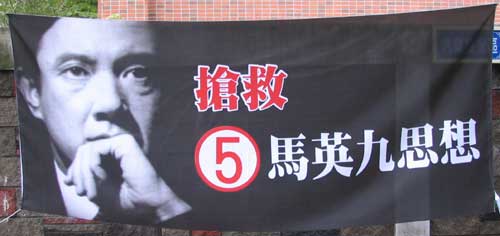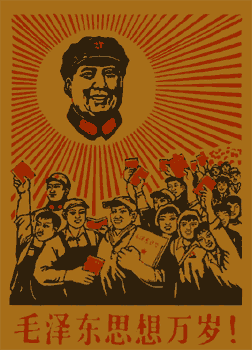Although the election has passed, here’s one more post on a Taiwan campaign banner.

This banner reads qiǎngjiù Mǎ Yīng-jiǔ sīxiǎng (“rush to save Ma Ying-jeou thought” / 搶救馬英九思想).
 This is an unusual banner for a number of reasons, not just because even die-hard KMT supporters might be hard pressed to say what exactly “Ma Ying-jeou thought” is. (I’m not trying to set up any punch lines here — really.)
This is an unusual banner for a number of reasons, not just because even die-hard KMT supporters might be hard pressed to say what exactly “Ma Ying-jeou thought” is. (I’m not trying to set up any punch lines here — really.)
Referring to a prominent figure’s “thought” is much more common in China than in Taiwan and is predominantly associated with Mao Zedong — not the sort of figure to attract votes from pretty much any segment of Taiwan’s electorate.
The standard phrase is Máo Zédōng Sīxiǎng (毛澤東思想 / 毛泽东思想 / “Mao Zedong Thought”). See, for example, the Cultural Revolution-era poster at right, which reads “Mao Zedong Sixiang wansui!” (“Long live Mao Zedong Thought!” / 毛泽东思想万岁). As far as I know, though, people in China didn’t have to urgently rush to save it. Searches on Google and Baidu for “抢救毛泽东思想” (“rush to save Mao Zedong thought”) yield no responses at all. On the other hand, giving a Japanese reading of “banzai!” for wansui (万岁) might change the feeling of urgency some.
Before turning to a look at numbers, I’d like to offer a few more observations about this banner:
- The candidate isn’t Ma Ying-jeou, though Ma is the only person shown here and the only one to have his name mentioned. The only way to identify this candidate would be through the candidate number. Even Ma being head of the KMT doesn’t help, since candidates’ political affiliations are not given on the ballot other than in presidential elections.
- A campaign-material color scheme of black and red doesn’t indicate an anarcho-communist candidate but rather a supposedly urgent need to vote for someone. A candidate who uses predominantly black campaign material is one whose election may hang by a thread and so needs all the help he or she can get. But this is usually nothing but a campaign gimmick.
Here’s a table of the results of Google searches for the “thought” of some prominent political figures, with Confucius thrown in for good measure, as he was more of a real philosopher than all the rest of them put together. Also, to give a sense of the relative numbers of Web pages, I’ve added the search results for 的, the most frequently used Chinese character; this provides a very rough and unscientific ratio of about 2.4 Web pages in China for every 1 Web page in Taiwan.
I ran four variations on each main search. In addition to looking for the exact phrase of “[someone’s] thought” I checked the results as restricted to .tw domains, .cn domains, Taiwan governmental domains, and PRC governmental domains.
| Search phrase | Translation | Total | .tw | .cn | .gov.tw | .gov.cn |
|---|---|---|---|---|---|---|
| 的 | de | 769,000,000 | 95,100,0000 | 246,000,000 | 15,800,000 | 35,900,00 |
| 毛澤東思想 | Mao Zedong thought | 2,330,000 | 8,200 | 1,140,000 | 174 | 342,000 |
| 孔子思想 | Confucius thought | 64,000 | 3,160 | 21,500 | 200 | 2,860 |
| 鄧小平思想 | Deng Xiaoping thought | 27,800 | 256 | 14,900 | 12 | 1,660 |
| 孫中山思想 | Sun Yat-sen thought | 10,300 | 1,210 | 2,720 | 196 | 361 |
| 江澤民思想 | Jiang Zemin thought | 4,120 | 59 | 573 | 5 | 98 |
| 胡錦濤思想 | Hu Jintao thought | 2,400 | 34 | 1,140 | 0 | 198 |
| 蔣介石思想 | Chiang Kai-shek thought | 850 | 15 | 251 | 0 | 17 |
| 馬英九思想 | Ma Ying-jeou thought | 326 | 31 | 1 | 0 | 0 |
| 李登輝思想 | Lee Teng-hui thought | 85 | 52 | 2 | 0 | 0 |
| 蔣中正思想 | Chiang Kai-shek thought
(alternate form) |
54 | 27 | 0 | 7 | 0 |
| 蔣經國思想 | Chiang Ching-kuo thought | 34 | 11 | 7 | 0 | 0 |
| 陳水扁思想 | Chen Shui-bian thought | 33 | 7 | 6 | 0 | 0 |
Thus, the phrase “[somebody’s] thought” is overwhelmingly a PRC usage and associated with Mao Zedong more than with all the others put together and multiplied by 20. So what’s it doing here with Ma Ying-jeou’s name?

You wrote:
– – –
# […] The only way to identify this candidate would be through the candidate number. Even Ma being head of the KMT doesn’t help, since candidates’ political affiliations are not given on the ballot other than in presidential elections.
# A campaign-material color scheme of black and red doesn’t indicate an anarcho-communist candidate but rather a supposedly urgent need to vote for someone. […]
– – –
Haven’t you noticed the colors of the “uniforms” the KMT are wearing these days? Black vests with red collars. My wife is quite convinced that it was a KMT candidate.
You concluded with this:
– – –
Thus, the phrase “[somebody’s] thought” is overwhelmingly a PRC usage and associated with Mao Zedong more than with all the others put together and multiplied by 20. So what’s it doing here with Ma Ying-jeou’s name?
– – –
I made a similar comparison in a post I wrote back in March of this year or in another post I wrote in February where I referred to “Chairman Ma” as “Mao-without-the-‘o’.”
Let us know if you find out what the candidate’s name was and if the voters fell in line with the prescribed Ma-ist thought.
Tim Maddog
I saw a campaign poster featuring Ma and the word ?? [gémìng] (revolution). It seemed a little strange to me.
Here’s another juxtaposition of “Mao-minus-O” and “Ma-plus-O” from yesterday’s Liberty Times. From the text accompanying the second image there, it looks like those two (and James Soong) share as an ancestral home a village in Hunan Province, China. They also seem to share the trait of bringing chaos to the countries in which they live(d).
Pingback: Pinyin news » wanted: linguistically interesting Taiwan campaign material
I’m wondering if these might be hoaxes in order to discredit Ma? Interesting to say the least…
The banner dates back to an election for neighborhood chiefs (lizhang) nearly two years ago, long before the current presidential campaign. So I think it’s probably just what it appears to be: someone trying to associate himself with Ma, though in an odd way. I doubt the use of the photo was authorized.
I failed to mention in the original post that the photo was taken in Banqiao, not far from my apartment.